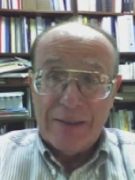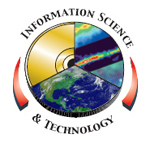
Please Note: The content on this page is not maintained after the colloquium event is completed. As such, some links may no longer be functional.
Daniel Mandl and Dr. Stephen Ungar

NASA GSFC
SensorWebs as an Enabling Step for Holistic Remote Sensing
Wednesday, May 22, 2012
Building 3 Auditorium
3:30 PM
(Reception to follow)
SensorWebs are systems consisting of multiple sensors together with a centralized or a distributed information processing system which act as a cohesive whole. The sensors can be homogeneous or heterogeneous and the system transforms the diverse data sets into information. Much like replacing a line with net to provide the ability to include fish as a stable component of the human diet, SensorWebs enable increased breadth and speed to remote sensing. The sensors can be homogeneous or heterogeneous and the system transforms the diverse data sets into information. This provides leveraged sensing power via the addition of cloud computing, high speed onboard processing and rapidly fused data products.
Remote sensing can be defined as the pursuit of determining parameters through indirect measurement when direct measurement is elusive. An obvious example is the determination of solar and planetary surface temperature by astronomers through measurement and analysis of the radiation reaching their telescopic observing instruments. Sometimes it is less risky and more practical to gather information, that can in principal be gleaned through direct observation, indirectly through the use of drones for obvious reasons. Remote sensing of the Earth from satellites provides a pathway to determining parameters such as sea surface temperature on a global scale not feasible through direct measurement.
From the science perspective, a key challenge of remote sensing is how to relate the indirect measurement to the more traditional in situ measurements. This challenge has led us to look beyond merely trying to map remotely sensed measurements into traditional measurements, but rather to look at how the measurements are used to address science and applications needs. This talk describes the development of a 'holistic' approach to remote sensing and the critical link, enabled by Sensorwebs, between observation and science/application need.
Daniel Mandl began his career at Goddard in 1980 and over the next eighteen years led ground system component development efforts such as control center systems and subsystems for Dynamic Explorer (DE), Cosmic Background Explorer (COBE), Gamma Ray Observatory (GRO), Extreme Ultraviolet Explorer (EUVE), Upper Atmospheric Research Satellite (UARS), Solar Anomalous and Magnetospheric Particle Explorer (SAMPEX), Fast Auroral Snapshot Explorer (FAST) and Wide Field Infra Red Explorer (WIRE). In 1998 he became the Earth Observing-1 (EO-1) Ground System Manager (for Development) and late in 2001 transitioned to the EO-1 Mission Manager. After two successful years of operations, he spearheaded an effort to use EO-1 as an orbital testbed. During the next 11 years, various functionality was added to the EO-1 mission to conduct SensorWeb experiments which included onboard autonomy (Autonomous Sciencecraft Experiment-JPL), onboard model-based diagnostic and recovery software (Livingstone - Ames), Open Geospatial Consortium (OGC) SensorWeb Enable (SWE) web service access and control of EO-1 sensors and a number of other experiments Further testbedding was conducted to examine the infusion of these and other capabilities for future missions using high speed onboard multicore processing and automated parallelization of single threaded programs to optimize data processing throughput in a low powered environment. These experiments were conducted and are ongoing under funding from four successive three-year NASA Earth Science Technology Office (ESTO) research grants on the topic of SensorWebs and two ESTO QRS grants for which Dan is/was the PI, an unsolicited grant from NASA Applied Sciences, various Internal Research and Development (IRAD) grants, partners with Small Business Innovation and Research (SBIR) grants, and the HyspIRI and EO-1 projects. Dan established collaborative efforts with JPL, Ames, the Open Geospatial Consortium(OGC), Open Cloud Consortium (OCC), Group on Earth Observations (GEO), Committee on Earth Observation Satellites (CEOS), the National Hydrological Services in Namibia and other international organizations to provide real world test cases using SensorWeb for disaster management decision support.
'SensorWeb' software won Honorable Mention for the 2011 NASA Software of the Year Award. In addition, Dan received the Robert H. Goddard Award of Merit for 2013 for his SensorWeb and other related technical leadership efforts. He also received the 2007 NASA Exceptional Achievement Award for the transformation of EO-1 into an orbital testbed and also using the SensorWeb technology to reduce the cost of operations. The SensorWeb team was bestowed the R&D Magazine '2008 R&D 100 top technology innovations introduced to market' for SensorWeb. Dan received his BSEE from Univ. of Maryland College Park in 1979 and his Masters in Engineering Management from George Washington University in 1995. He has over 50 publications and meeting presentations on the topic of SensorWebs and other satellite mission technology.
Dr. Stephen G. Ungar currently occupies a position as a Scientist Emeritus at the NASA Goddard Space Flight Center (GSFC), with a half-time appointment as a Senior Research Scientist at the University Space Research Association (USRA) under the NASA/USRA Goddard Earth Sciences, Technology and Research (GESTAR) program. He also participates in the formulation of NASA's future HyspIRI Mission as a member of both the HyspIRI Steering Committee and The HyspIRI Science Study Group.
Dr. Ungar served as the Earth-Observing 1 (EO-1) Mission Scientist from the mission's inception in 1996 until his retirement from NASA in April 2008. He also served as the Project Scientist for NASA's Morning Constellation, consisting of the Landsat-7, EO-1, SAC-C, and Terra satellites flying in formation. Upon retirement, Dr. Ungar received a Scientist Emeritus appointment at the NASA GSFC. Additionally, he held the position of Senior Research Scientist at the University of Maryland Baltimore County (UMBC) from July 2008 until transitioning to USRA in May 2011. Dr. Ungar participates in many international venues and served as Chair of the Committee on Earth Observing Satellites (CEOS) Working Group on Calibration and Validation (WGCV). He served as Task Leader for the GEO Task on Data Quality Assurance across the 9 GEO Societal Benefit Areas and was an official delegate to the 2007 GEO Earth Summit in Cape Town, South Africa. Dr. Ungar received the NASA Medal for Exceptional Achievement, on December 4, 2002, 'in recognition of his role in advocating and maintaining high scientific standards resulting in data far surpassing the expectations of the user community for the EO-1 technology'.
IS&T Colloquium Committee Host: Jacqueline Le Moigne
Sign language interpreter upon request: 301-286-7040
